How to Locate and Turn Off Main Water Shut-Off Valves
During plumbing emergencies, such as a burst pipe or another plumbing catastrophe, it is important to know where your water shut-off valves are located and how to shut them off.
When you have a sewage backup or an overflowing appliance, you don’t want to look like a chicken with its head cut off looking for how to turn off your water supply. A little knowledge about where your plumbing valves are located and how to shut them off will go a long way – you may find yourself sprinting there someday.
In addition to isolation shut-off valves, which are connected to specific areas of your home, there is also a main water shut-off valve which shuts off water to the entire plumbing system. It’s good to know where both your main water valve and all the individual isolation valves are located.
Let’s start with the isolation valves.
Where are my isolation valves?
Isolation valves, also known as service valves, are normally located near the fixture that it is connected to, whether it be a toilet or a washing machine. There are separate plumbing valves for each of your different plumbing fixtures, allowing you to work on a small section of your plumbing system without having to cut the water supply to your other water using fixtures and appliances.
Next time you use your toilet, washing machine, or sink, look for the isolation valve, connected to the pipes entering your fixture. For your washer machine and sinks, there will be separate hot and cold water supply lines with separate shut-off valves, while your toilet only has one cold water shut-off valve. If you have an overflow problem with one of your fixtures, simply shut off the isolation valve to contain the situation.
How do I turn off isolation valves?
There are several different types of isolation valves, but they all are pretty simple to turn on and off. If you are finding it difficult to turn the valve, try putting on work gloves or use a wrench if necessary, but never force a valve open or closed. It’s a good idea to turn your isolation and main water valves on and off every once in a while so they remain easy to turn.
Warning: Never try to force your valve open or closed! You could end up breaking the valve and causing a plumbing nightmare. Hand tightening and loosening should be all you need. If the valve seems stuck, don’t try to force it. Call your local plumber instead as you could end up causing irreversible damage.
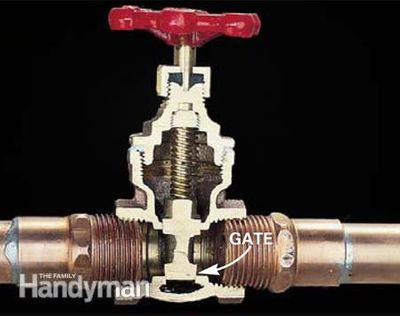
Gate Valve:
A gate valve closes off the water supply by lowering a brass gate into a slot. They should always be completely on, or completely off. To turn off a gate valve, simply remember the old adage, “Righty tighty, lefty loosey.”
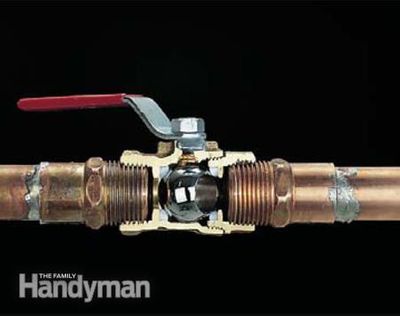
Ball Valve:
A ball valve is a little different. A ball valve uses a ball with a hole in it to pivot into the right position. To turn a ball valve off, turn the lever so that it is perpendicular to the pipe. To turn it on, make sure the lever is parallel to the pipe.
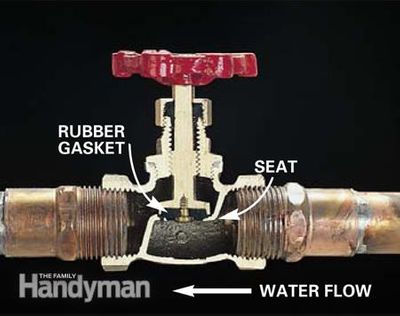
Compression Valve:
Compression valves, also known as stop valves, use a rubber gasket that gets screwed into the middle portion of the valve, stopping water flow. As with the gate valve, turn the handle right to close off the water supply and loosen it to the left to open it up. Since the water path isn’t the most efficient, these types of valves will only be used as isolation valves for sinks, toilets, etc.
Main Water Shut-Off Valve
Knowing where your isolation valves are located is great for shutting off water to just one area of the home, but what if you need to shut off the entire water supply entering your home? We highly recommend that every member of the household knows where the main water shut-off valve is located and how to turn it off in the case of an emergency.
Where is my main water shut-off valve?
Every house has at least one main water shut-off. Look for where the plumbing enters the home to find yours. There are a couple main spots to check inside first before heading outside to look. You can save yourself some time by checking your property inspection report, if you know where that is.
If you have a basement and crawl space, the main water shut-off is probably located in the basement, near the front wall of your home (closest to the street). It should be very close to your water meter, where you can detect the amount of water your home uses and if you have a plumbing leak somewhere in the system, although some homes don’t have a meter.
The handle with be a strong gate or ball valve, looking something like this:
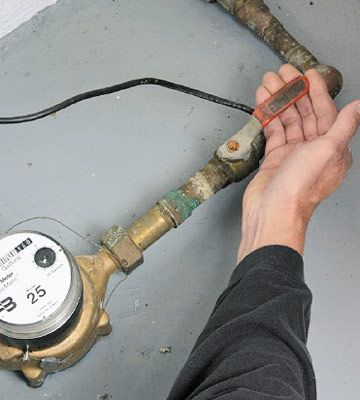
If your home was built on a slab, the main water shut-off could be located near your hot water heater or inside of your garage.
If you cannot find your main water shut-off inside the home, the next place to look is outside, near the front curb. What you’ll be looking for is a cement box, also known as a Buffalo box, buried underground. The visible portion of the box will probably be a heavy iron cover that says “WATER” or “WATER METER” on it. You may need to dig around the grass to find the lid.
Once you find the lid to your water meter, you can usually pry it open with a large screwdriver, but sometimes it may require a special “meter key” to open. You can find meter keys at any local hardware store. Additionally, the valve inside the box may require a special key as well.
Once you get the lid open, you may find something like this:
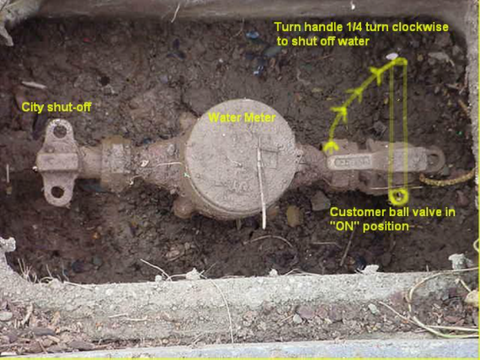
Never touch the city side of the valve as it is illegal to do so. Also, if you wish to adjust the water pressure at any of your valves, make sure you know exactly what you are doing; otherwise call a plumber. Additionally, if you have any questions about your main water valve, don’t hesitate to call Pipe Doctor for answers.
If your pipes freeze, do NOT turn off your water. In fact, you should turn both hot and cold lines on a little bit as you begin to thaw your pipes (always thaw in the direction of water flow). If your pipes burst, then you SHOULD turn off the main water valve immediately and call Pipe Doctor at 419-550-1541.
